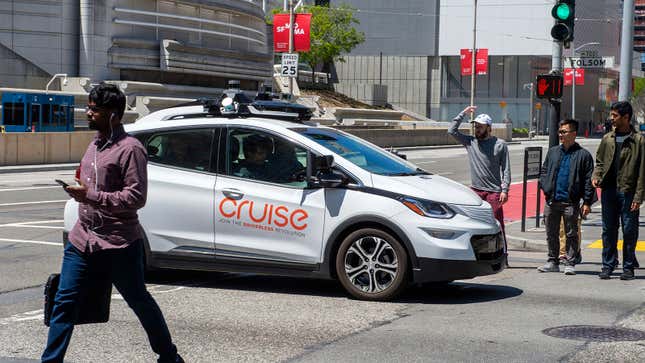
San Francisco has just about had it with Cruise autonomous cars clogging up intersections, driving on sidewalks and even escaping arrest, or whatever it is the police do to a robotaxi that has become ungovernable. Last week, the city wrote the statehouse requesting that officials intervene with the rollout of General Motors’ driverless service, as well as Alphabet’s Waymo. Two damning letters took aim at everything from the companies’ push for blanket, city-wide, 24/7 approval, to their insistence on confidentiality when issues do arise.
“If the [California Public Utilities] Commission approves sweeping authorizations for both Waymo and Cruise, the hazards and network impacts caused by planned and unplanned AV stops that obstruct traffic could soon affect a large percentage of all San Francisco travelers,” representatives of the San Francisco County and Municipal Transportation Agencies wrote in a letter dated January 25. “Preventing and mitigating travel lane AV failures calls for continuous collaboration between industry and all levels of government.”
The agencies propose a number of alternative measures. First and foremost, the city wants the robotaxis kept out of downtown, and to circulate only during off-peak hours — outside 7 to 10 a.m. and 4 to 7 p.m. The letter also demands that confidentiality around basic operational data must not be a condition of approval, and that when fleet expansions do occur, they happen in agreed-upon, predetermined increments, tens or hundreds of cars at a time.
Cruise has received the bulk of attention around these mishaps, as it began accepting fares in San Francisco for driverless ride-hailing services last summer. Waymo, which is operated by the same parent company that owns Google, is moving a little more slowly and has not yet started charging the public for rides — though that’s not for lack of trying. Up until December, Waymo employees had to ride alongside passenger in the test vehicles, just in case.
San Francisco transportation officials are aware that the data appears more heavily skewed against Cruise than Waymo for this reason, as they explain in one of their letters:
The large majority of unplanned travel lane AV stops reported through December 2022 involved Cruise AVs rather than Waymo vehicles. However, because the Commission does not currently collect data on these incidents, and they are not reported to the City, it is not possible to fully understand their frequency or overall effects. The low rate of complaints involving Waymo vehicles may reflect a lower volume of Waymo driverless vehicle miles traveled (VMT) rather than superior Waymo performance—or could reflect both VMT and performance differences.
As for Cruise, the California Department of Motor Vehicle already cleared GM’s robotaxi wing for blanket expansion — every street, any time of day — last month. However, Cruise can’t go through with its plan until the Public Utility Commission also gives its blessing, which is why the city is pressing the group to think things over. Considering even employees within the company have expressed doubts about expansion, that would seem to be the common sense move.
